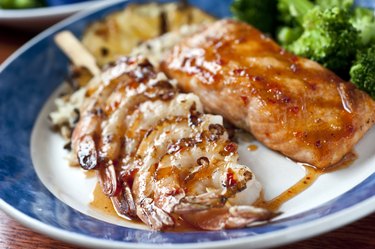
Candida is a yeast-like fungus in the digestive tract that, when present in normal amounts, does not cause problems. When candida grows excessively it is a condition known as candidiasis, or yeast infection. According to the University of Maryland Medical Center, yeast infections are most common among women, HIV/AIDS patients and others with depressed immune systems. An anti-candida diet generally limits foods containing yeast, added sugar and processed foods and encourages intake of foods that may inhibit candida overgrowth.
Vegetables and Fruits
Video of the Day
Vegetables provide an assortment of nutrients, including antioxidants that can help your body defend itself from infections and disease. According to Pervasive Developmental Disorders: Diagnosis, Options, and Answers, by Mitzi Waltz, many anti-candida diets limit dried and acid fruits, such as citrus fruits, pineapple and tomatoes. In some cases, all fruits are limited until your symptoms subside. Since vegetables and fruits are important for your overall wellness, consume a variety regularly unless a health care professional suggests otherwise. Vegetables rich in fiber may be particularly helpful for those looking to inhibit candida growth, according to Waltz. High-fiber vegetables include kale, spinach, broccoli, artichokes, Brussels sprouts, cabbage, avocado, lima beans, parsnips, peas and garbanzo beans.
Video of the Day
Carbohydrates
Complex carbohydrates, such as whole grains and starchy vegetables, provide rich amounts of nutrients, dietary fiber and glucose—your body's primary energy source. Since most commercially prepared breads and baked goods contain yeast, take special care in selecting yeast-free carbohydrate options. According to the University of Maryland Medical Center, consuming a diet rich in B vitamins and vitamin C may help prevent or reduce candidiasis symptoms. Long-grain brown rice, wild rice, old fashioned and steel-cut oats, barley and quinoa are naturally yeast-free and rich in B vitamins. Starchy vegetables rich in vitamin C include sweet potatoes, yams, canned pumpkin, pumpkin squash, winter squash and butternut squash. Avoid all breads, cereals, crackers, cookies, chips and other starches that list yeast on the ingredients list and foods that list sugar, corn syrup, dextrose, sucrose or other added sugars. For best results, purchase breads and other baked goods specifically labeled "yeast-free" from your local health food grocery store.
Protein-Rich Foods
Protein supports lean tissue development and tissue repair. Since protein-rich foods digest slowly, they tend to promote positive blood sugar balance and sustained energy. According to Waltz, an effective anti-candida diet is devoid of fermented foods, such as aged cheese, and in some cases, dairy products. However, cultured dairy products contain healthy bacteria known as probiotics, which may help prevent or alleviate yeast overgrowth. If you find that dairy products trigger yeast infections, limit or avoid milk, ice cream, cheese and creamy sauces. If yogurt causes adverse reactions, you may reap similar anti-fungal benefits from dairy-free probiotic supplements. Fortunately, many protein-rich foods are yeast-free and fit well within a candida-prohibiting diet. Choose lean, natural protein sources most often, such as skinless chicken and turkey breasts, beans, lentils, split peas and, if possible, low-fat yogurt. Omega-3 fatty acids can help prevent candida outbreaks, according to the University of Maryland Medical Center; to reap benefits of omega-3 fat, consume fatty fish, such as wild Alaskan salmon, albacore tuna, sardines, herring, mackerel and halibut, regularly.